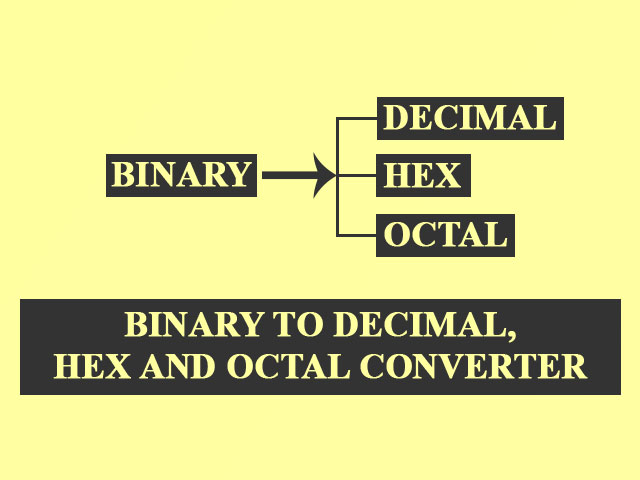Binary to Decimal, Hex, and Octal Converter
Welcome to our Binary to decimal, octal, and hexadecimal converter. Through this converter, you can convert some binary numbers, to other number systems, like decimal, octal, and hexadecimal number system.
If you want to convert the given binary number into other different number systems, like the decimal number system, octal, and hexadecimal number system, you can use our free converter.
How to use this converter?
This converter for converting a binary number to decimal, octal and hexadecimal numbers, is an easy-to-use tool, and you can get the corresponding outputs in very less time.
You have to input the given binary number into the first input box, and just hit the calculate button. After this, you have the corresponding inputs in the respective boxes.
The binary number system uses two digits only, which are 0 and 1. Here, all the numbers that are going to form after these, are going to be from these two digits only. For example, the binary equivalent for 12, is 1100.

Binary to decimal conversion
Well, conversion from a binary number to a decimal number is easy. For the conversion, we have to move from the right end to the left end of the binary number. For each binary digit from the right, we are going to multiply it by 2 to the power something, going towards the left, and we have to keep increasing the power. Lets us understand this with an example –
Let’s say that we are required to convert 1100 into a decimal system. Here, the right end has got a binary digit 0. so, we are going to initially multiply 0 with 2 to the power 0 (20). Then for the next digit(to the left), which is again 0, we are going to multiply it with 2 to the power 1 (21), and we are going to continue this, till we reach the leftmost digit, which would be multiplied with the highest power of 2 according to the digits. So, in our case, it becomes something like this –
(1 × 23 )+ (1 × 22 )+ (0 × 21 )+ (0 × 20) = 8 + 4 + 0 + 0 = 12.
So, as you can see, going from right to left, we are multiplying the corresponding binary digits by some appropriate power of 2.
You can try some other examples as well, so as to understand the concept of converting the value from binary to decimal number system.
Binary to Octal conversion-
The binary number to octal number conversion is very simple. As the octal numbers have base 8, we are going to pair 3 digits each, in the binary number, moving from right to left in the binary number. Here is an example –
1100 is the number, for example, then the pairs of 3 digits from the right are going to be something like this 001 100. Those zeroes on the left were added because we had not enough digits on the left side of that 1(it makes no difference since we are multiplying the number by 0 in the end, so the number won’t change).
As now we have the pairs as 001 100, we are going to convert them to decimal. The conversion from binary to decimal is pretty simple. The result comes out to be 1 4, so the octal equivalent for the binary number 1100 is going to be 14.
Refer to the below table, which contains some binary numbers, with their equivalents in the octal number system.
| Octal Digit Value | Binary Equivalent |
| 0 | 000 |
| 1 | 001 |
| 2 | 010 |
| 3 | 011 |
| 4 | 100 |
| 5 | 101 |
| 6 | 110 |
| 7 | 111 |
Binary to hexadecimal conversion –
The binary to hexadecimal conversion is pretty simple. As the hexadecimal numbers are having base 16, we are going to pair 4 digits each this time, going from right to left in the binary number. Let’s understand this with an example –
For example, 1100 is the binary number that we need to convert into the hexadecimal format, so we are going to make pairs of 4 here. In this case, only one pair is possible, which is 1100. now, we have the task of converting these binary pairs(only one in this case) to decimal, which is pretty easy, and we know it comes out to 12. But in the hexadecimal number system, we consider the numbers from 0 to 9, and for the numbers from 10 to 15, we have the alphabets from A to F. So, 12 is going to be equivalent to some alphabet, which is C. So, the hexadecimal equivalent for 1100 comes out to be C.
This was pretty straightforward. If we try a quite bigger example, let’s try for 110010010, which comes out to be 402 in binary. Let’s pair 4 binary digits each going from right to left. The pairs come out to be like this – 0001 1001 0010. The extra zeroes that you can see on the leftmost side, are because we did not have enough numbers at the last to make pair of 4. So, our next task is to convert those pairs into decimals, and then we are done.
So, this binary to decimal conversion comes out to be – 1 9 2. so, the hexadecimal equivalent for the binary number 110010010 comes out to be 192.
Here is the table for some binary numbers, and their equivalents in the hexadecimal system –
| Binary number | Hexadecimal equivalent |
| 0000 | 0 |
| 0001 | 1 |
| 0010 | 2 |
| 0011 | 3 |
| 0100 | 4 |
| 0101 | 5 |
| 0110 | 6 |
| 0111 | 7 |
| 1000 | 8 |
| 1001 | 9 |
| 1010 | A |
| 1011 | B |
| 1100 | C |
| 1101 | D |
| 1110 | E |
| 1111 | F |
FAQ About Binary to Decimal, Hex, and Octal Converter
Ans: Base for the binary numbers is 2.
Ans: Base for the hexadecimal number system is 16.
Ans: Base for the octal number system is 8.

